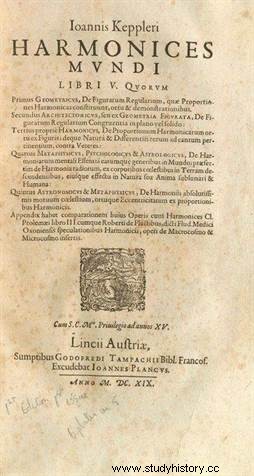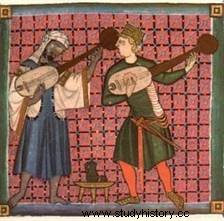 From the song of the monk, praising God six-eight hours a day to the improvisations of a minstrel or a troubadour, music gave rhythm by its omnipresence to daily life in the Middle Ages, both in collective and private life. However, medieval society did not think of music , he thought according to music, seen as a keystone of Christian society in the West. From this stems a philosophical conception inherited from Greco-Latin antiquity, adapted to Christianity by the Fathers of the Church, making music both an art and a mathematical, philosophical and divine science contributing by its harmony to the order of the world.
From the song of the monk, praising God six-eight hours a day to the improvisations of a minstrel or a troubadour, music gave rhythm by its omnipresence to daily life in the Middle Ages, both in collective and private life. However, medieval society did not think of music , he thought according to music, seen as a keystone of Christian society in the West. From this stems a philosophical conception inherited from Greco-Latin antiquity, adapted to Christianity by the Fathers of the Church, making music both an art and a mathematical, philosophical and divine science contributing by its harmony to the order of the world.
The Greco-Latin heritage of music in the Middle Ages
From Greek Antiquity to the 16 th century is perpetuated a theory according to which the universe is governed by harmonious numerical relations and that the distances between the planets are distributed according to musical proportions. This is what we traditionally call the music or the harmony of the spheres. At the time, only 7 planets (Moon, Mercury, Venus, Sun, Mars, Jupiter, Saturn) are known to revolve around the Earth – it will be necessary to wait for Copernicus and heliocentrism in the XVI th so that the planets revolve around the Sun – corresponding to the 7 musical intervals (minus the octave) from a mathematical point of view. This idea of a cosmic music is of Pythagorean origin. It became popular among Greek philosophers, notably thanks to Plato in his Timaeus and his Republic but also thanks to Aristotle. The theory of the harmony of the spheres subsequently prospered under the pen of illustrious Latin authors such as Pliny or Cicero and remained alive in the neo-Pythagorean and neo-Platonic schools with authors such as Macrobius or Martianus Capella.
 Nevertheless, it was above all the philosopher Boethius who synthesized around 510 the fundamental principles of Pythagorean and Platonic theory. His treatise, De institutione musica , became the essential reference throughout the Middle Ages. His work is indeed hoisted to the rank of "best-seller" among medieval musicologists and appears to be the reference manual in musical education at the University of Paris in the 13
th
. century.
Nevertheless, it was above all the philosopher Boethius who synthesized around 510 the fundamental principles of Pythagorean and Platonic theory. His treatise, De institutione musica , became the essential reference throughout the Middle Ages. His work is indeed hoisted to the rank of "best-seller" among medieval musicologists and appears to be the reference manual in musical education at the University of Paris in the 13
th
. century.
In it, it organizes the music into three categories:the musica mundana , the musica humana and musica instrumentalis . The first, the music of the world (the harmony of the spheres) is at the top, it harmoniously orders the universe. Human music corresponds to the harmonic relationship between the soul and the body, it is produced by the human body. The last characterizes the music of the instruments and the voice, it is the only music a priori perceptible by the senses. Thus, if Boethius distinguishes a musical practice linked to the field of the sensitive, he presents music above all as a speculative and rational science organized around numbers.
A mathematical science?
As strange as it may seem to us today, music in the Middle Ages was not only taught as an artistic discipline but above all as a mathematical discipline. For Boethius, only the theoretical aspects of music are worthy of study since musical practice is a matter of the manual work of the craftsman, instinct and servitude. His treatise thus examines the different kinds of proportions, consonances and dissonances according to their mathematical nature.
 It is this conception of music as a mathematical science that is taught throughout the Middle Ages, mainly within the quadrivium liberal arts. At the Medieval University, all "students" begin their studies with a common base of disciplines:the study of the liberal arts divided into two categories:the trivium and the quadrivium . The trivium brings together the subjects of the language:grammar, dialectics and rhetoric. As for the quadrivium , it brings together the four mathematical sciences of arithmetic, geography, astronomy and music.
It is this conception of music as a mathematical science that is taught throughout the Middle Ages, mainly within the quadrivium liberal arts. At the Medieval University, all "students" begin their studies with a common base of disciplines:the study of the liberal arts divided into two categories:the trivium and the quadrivium . The trivium brings together the subjects of the language:grammar, dialectics and rhetoric. As for the quadrivium , it brings together the four mathematical sciences of arithmetic, geography, astronomy and music.
However, music occupies a sometimes shifting place between trivium and quadrivium , the mastery of singing being similar to the mastery of speech and therefore to rhetoric. Moreover, in addition to the writings of Boethius, another musical treatise appears universally known and used during the Middle Ages, it is the De musica of Saint Augustine. The latter, bishop of Hippo in the IV th century, considers music as the "science of the number made audible" allowing good modulation. From then on, he undeniably placed this discipline on the side of mathematics, but he also understood music as the mirror of universal harmony, in other words, the reflection of divine beauty.
From spiritual science to musical practice
For Christian theorists of the Middle Ages, music allows reason to rise to the contemplation of beauty and divine wisdom. From a mathematical science, music is considered a spiritual and philosophical science allowing to approach the divine. This explains its omnipresence in the medieval liturgy. But this conception of music therefore requires recourse to musical practice. The encyclopaedist Vincent de Beauvais in the 13 th century summarizes music both from a theoretical and physical point of view, focusing on describing strictly musical aspects of the discipline such as rhythm, melodies, and musical instruments. He places himself in the tradition of the famous musicologist of the XI e century Guy of Arezzo, inventor of the western musical notation system, who partly rejects Boethius' treatise, judging it more useful to the philosopher than to the singer.
Many medieval thinkers, mainly from the end of the XIII e century then distanced themselves from the founding texts of musical conception, putting the practical aspect in the foreground more than the theory. For them, music should serve human pleasure and not be limited to the praise of God. This break provoked theological debates on the place and role of music. We can think of Thomas Aquinas, who in his Summa Theologica , accepts the pleasures and entertainments that a juggler can provide in moderation for the common good of society.
Finally, let's quote the formula of the most famous French composer of the XIV e century, Guillaume de Machaut:"And music is a science that wants us to laugh and sing and dance:cure has no melancholy". This shift in the conception of music at the end of the Middle Ages is to be compared with the artistic development represented by the ars nova . These changes also reveal the duality of this discipline.
Music in the Middle Ages:a multifaceted conception
 Throughout the Western Middle Ages, the Christian conception of music presented itself in the form of an astonishing antagonism existing since Greek antiquity. 13th Century Inquisitor Preacher century, the Dominican Étienne de Bourbon recounts in his stories an episode of the Odyssey of Homer. This is the famous passage where Odysseus covers his ears so as not to hear the irresistible songs of the sirens.
Throughout the Western Middle Ages, the Christian conception of music presented itself in the form of an astonishing antagonism existing since Greek antiquity. 13th Century Inquisitor Preacher century, the Dominican Étienne de Bourbon recounts in his stories an episode of the Odyssey of Homer. This is the famous passage where Odysseus covers his ears so as not to hear the irresistible songs of the sirens.
Through this story, Étienne de Bourbon wishes to warn the faithful against the psychological effects of music. For medieval thinkers, music can influence the soul of man. It therefore has a strength that can be both useful to Christian society and also harmful. While music has therapeutic effects recognized by both musicians and medieval physicians, the latter consider its effects to be unpredictable and therefore dangerous. All music is not good and the Fathers of the Church insistently combat pernicious music, symbol of a "decadent and effeminate" pagan art. Clement of Alexandria seeks to ban artificial music which leads to idolatry. John Chrysostom seeks to flee her because of the danger of adultery. He particularly denounces the beguiling voices of women.
As such, one of the greatest dangers for Christian theologians appears to be the juggler – or actor, troubadour, comedian, etc. –, generally considered as an interpreter of the devil who cannot be buried in consecrated ground – let us think of the much later but equally revealing case of Molière –. However, here again the vision of the actor is not uniform during the Middle Ages. Medieval theologians valued his oratorical and musical talents. They do not hesitate to make the biblical figure of King David the “juggler of God”. Medieval clerical literature abounds with stories where, through his art, the minstrel can convert the faithful to the divine faith. This example is revealing of two conceptions of music that are indefatigably confronting each other. If for theologians, music makes it possible to praise the divine greatness, it can also be pernicious and lead the faithful into sin. Musical practice can both participate in the salvation of the soul and lead to damnation.
The design of medieval music is far from uniform. Between so-called scholarly or aristocratic music, philosophical science or art, oral or written, belonging to the sphere of the sacred or the profane, it cannot allow itself to be partitioned by a precise definition. Far from being fixed both in theory and practice, music lends itself to many interpretations and evolves with the times. It thus leaves to the historian a fantastic testimony of the cultural and societal stakes of the Middle Ages.
Bibliography
- Jacques Chailley, Musical History of the Middle Ages, Paris, PUF, 1950.
- Martine Clouzot and Christine Laloue (dir.), Representations of music in the Middle Ages, proceedings of the colloquium of April 2 and 3, 2004, Paris, Cité de la musique, 2005.
- Olivier Cullin, Brief history of music in the Middle Ages, Paris, Fayard, 2002.
- Olivier Cullin (ed.), The place of music in medieval culture, Turnhout, Brepols, 2007.
